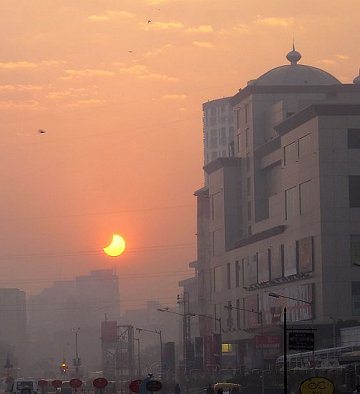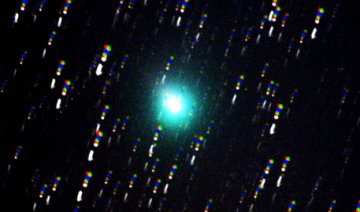 The space shuttle flies in April. Would you like a call when it soars over your backyard? Spaceweather PHONE!
The space shuttle flies in April. Would you like a call when it soars over your backyard? Spaceweather PHONE!
SOLAR ACTIVITY: This morning's dramatic solar prominences are fading--but they're still visible "with a little magnification," says astrophotographer Greg Piepol of Rockville, Maryland. Click here to see.
SOLAR ECLIPSE: When the sun rose over India this morning, something was missing--part of the sun! "It was a wonderful sunrise eclipse," says Dr. Prabodhan Potdar who took this picture from the city of Mumbai:

Photo details: Sony Cybershot P100, tripod, short timed exposure.
The missing piece was hidden behind the Moon, which passed in front of the sun for almost four hours around 02:32 UT. The resulting partial eclipse was visible from India, across China and Russia, all the way to the far reaches of northern Alaska. Click here for more photos from the eclipse zone.
March 19th Solar Eclipse Gallery
NEW COMET LOVEJOY: On March 15th, Terry Lovejoy of Thornlands, Australia, discovered a new comet (C/2007 E2) in the southern constellation Indus. Remarkably, to make the find he used not a telescope but just a camera--a Canon 350D. At Lovejoy's request, John Drummund of Gisborne, New Zealand, confirmed the comet with this photo taken through a 0.41-m reflector:

Photo details: 16" Newtonian @f5.2, SBIG STL11000M CCD, 3 minutes
The new comet is green and shines like a 9th magnitude star, too dim for the unaided eye but an easy target for large backyard telescopes in the southern hemisphere: ephemeris.
UPDATE: After four days of tracking, Comet Lovejoy's trajectory is known. The orbit is cockeyed, almost perpendicular to the rest of the solar system. At the moment the comet is swooping up from below, moving from southern to northern skies. At closest approach to Earth (0.44 AU) in late April, Comet Lovejoy is expected to brighten to 7th magnitude, still not a naked-eye comet but easy to see through small telescopes.
HAPPY EQUINOX: The 2007 vernal equinox occurs at 00:07 UT on March 21st (5:07 pm PDT on March 20th) when the sun shines straight down on our planet's equator. This marks the beginning of spring in the northern hemisphere and autumn in the southern hemisphere. Wherever you live, Happy Equinox!

